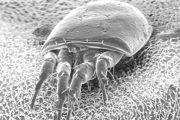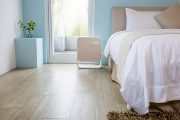You often hear that high-efficiency particulate air (HEPA) filters are one of the best filters used by air purifier owners to keep the air in their house clean and prevent allergic symptoms. But is a HEPA air purifier really worth it? Are HEPA air purifiers better than other types of filters? If you want to clean the air in your house, keep reading to see if a HEPA filter is the right choice for you.
Note: If you need answers to common questions about air purifiers, please read our air purifier FAQs.
Related posts
Is a HEPA air purifier worth it?
Yes, a HEPA air purifier is worth the investment if you want to significantly reduce dust and dirt, improve your indoor air quality, and prevent allergy and asthma symptoms. Even if you clean your house thoroughly, there are several ways for airborne particles to enter via daily activities and accumulate over time.
True HEPA air purifiers can remove ultrafine particles, including dust, dander, pollen, mold, and other common allergens in the home. The industry standard requires that the unit remove at least 99.97% of particles with a diameter of 0.3 microns. As a result, HEPA filters can be extremely beneficial to allergy and asthma sufferers.
Although the cost of a HEPA air purifier is rather high compared to non-HEPA air purifiers, it all depends on what you’re attempting to achieve or relieve. If you’re only looking to freshen up your air, the cost might not be worth it.
If you do decide that an air purifier with a HEPA filter is best for you, keep in mind that simply seeing the name “HEPA” on the box does not guarantee that the filter is functional. Ensure that it fulfills the U.S. HEPA standard, i.e., being able to capture 99.97% of particles sized 0.3 microns.
Terms like “HEPA-like” or “HEPA-style” are worthless since they do not indicate whether or not the filters match the HEPA filter standard. Some manufacturers who produce filters that fulfill the specification have begun to refer to them as “True HEPA filter”.
List of the best air purifiers
- 1, Best Air Purifiers (Air Purifier Ranking List)
- 2, Best Air Purifiers for Allergies and Asthma
- 3, Best Air Purifiers for Bedroom
- 4, Best Air Purifiers for Baby
- 5, Best Air Purifiers for Smoke
- 6, Best Air Purifiers for Dust
- 7, Best Air Purifiers for Mold
- 8, Best Large Room Air Purifiers
- 9, Best Air Purifiers for Pets
- 10, Best Air Purifiers for Office
What is a HEPA air purifier?
HEPA stands for high-efficiency particulate air (filtering or filtration). HEPA filters use a dense, random arrangement of fibers to catch airborne particles from the air. They extract particles using the physics of particles traveling through air flow. The way HEPA filters work is straightforward but incredibly efficient, and HEPA filters have now become the industry standard in the air purifiers on the market.
Since the introduction of the first HEPA air purifier, it has been an efficient helper in lowering indoor pollution as well as chronic asthma symptoms. A true HEPA air purifier is capable of trapping particles as small as 0.3 microns. The United States Department of Energy (DOE) has mandated that all filters labeled “HEPA” must filter at least 99.97% of airborne particles down to 0.3 microns. This is powerful enough to remove the majority of particulates from the air.
We strongly advise you to conduct additional research on this article: What is a HEPA filter?
How does a HEPA air purifier work?
A HEPA air purifier works by forcing the air through a tiny mesh using HEPA filters. This mesh then catches potentially dangerous allergens and irritating particles such as smoke, dust, dirt, pollen, and pet dander. The HEPA filter captures dirt and dust particles in three ways. Some particles collide with filter fibers and are absorbed as a result of the impact. When some certain dust particles move too close to a fiber and get stuck by interception, they are collected when traveling through the flowing airstream. Meanwhile, diffusion traps certain dirt particles at lower airstream speeds. Diffusion occurs when particles collide and are pulled into the HEPA filter’s fibers.
What are the pros and cons of a HEPA air purifier?
What are the benefits of a HEPA air purifier?
- Ensure less dust and airborne particles in your home: Installing HEPA filters in the home can quickly lower the number of many common airborne particles, including pet dander, pollen, smoke, and dust. As mentioned above, air purifiers with HEPA filters have been proven to be able to trap particles as small as 0.3 microns. Human eyes cannot even notice these small particles. The smallest visible particles are at least 50 to 60 microns in size.
- Improve indoor air quality: With many types of particles removed, HEPA air purifiers provide much cleaner air for you and your family.
- Reduce allergy and asthma symptoms: Fortunately, the particles that trigger allergy symptoms, such as dust, dander, and pollen, are big enough to be captured by a HEPA filter. Hence, HEPA air purifiers can help lessen allergy and asthma symptoms.
- Produce no byproducts: Other air purifiers, such as ozone, ionizers, and PECO, emit a harmful byproduct into the atmosphere. In contrast to them, HEPA air purifiers simply filter the air without adding any byproducts.
What are the disadvantages of a HEPA air purifier?
- Can’t remove all particles: Unfortunately, HEPA filters will not remove particles smaller than 0.3 microns from the air, including viruses, certain bacteria, and volatile chemical compounds (VOCs). VOCs are household substances such as hairspray and ammonia that are too tiny to be removed by a HEPA filter.
- Need regular filter replacement: Most HEPA filters are not washable and must be replaced on a regular basis since they catch the majority of particles in the air. As a result, they clog faster than more porous filters. HEPA filters should be changed at least twice as frequently as non-HEPA filters. HEPA filters, on the other hand, often last two to three years. Therefore, maintenance costs are rather expensive compared to other types of air purifiers.
- Consume more power: HEPA filters have a high density. It requires a strong fan to move air through it, which consumes more electricity.
What is the difference between HEPA and non-HEPA air purifier?
The main difference between HEPA filters and other regular filters is that they are made of thin glass fibers and activated carbon-based materials. Porous materials like cotton paper sheets and polyester are often used to make regular filters.
The table below, based on an EPA study, provides the MERV (minimum efficiency reporting value) rating of filtration material according to the usual pollutant that it addresses, as well as the typical filter type found in the MERV rating category (from HEPA to “HEPA-like” filters).
Even if the MERV number is solely performance-based, the table below can still be useful because it indicates the boundaries of typical filter types (e.g., higher-efficiency pleated filters vs. true HEPA filters).
Filtration-based air purifiers made by reputable companies should clearly show their MERV rating, as well as the size of particles and types of pollution they can handle.
| Rating | Particle removal capability | Particle size | Common contaminants | Filter type | Filtration material |
|---|---|---|---|---|---|
| MERV 1-4 | Under 20% | 10 µm (micron) | Pollen, sanding dust, textile and carpet fibers | 1) Throwaway Filters 2) Washable Filters 3) Electrostatic Filters | 1) 1-inch-thick fiberglass or synthetic media 2) Aluminum mesh, foam rubber 3) Passive self-charging woven polycarbonate |
| MERV 5 – 8 | 35% to 70% | 3 – 10 µm (micron) | All listed above plus household dust, lint, and mold spores | Throwaway Filters | Synthetic media |
| MERV 9 – 12 | 90% to 95% | 1 – 3 µm (micron) | All listed above plus lead dust, coal dust, and legionella or other bacterial spores | Pleated filters (HEPA-like, HEPA-type) | 1 to 6 inch thick cotton or polyester media on an extended surface |
| MERV 13 – 16 | 75% to 95% | 0.3 – 1 µm (micron) | All listed above plus cooking oil droplets, most smoke, exhaled respiratory particles, toner, dander, and auto fumes | High-efficiency filters | Densely packed fibers |
| HEPA | 99.97% | 0.3 µm (micron) | All listed above plus smoke particles, fine dust, and most allergenic fragments | High-efficiency filters | Densely packed fibers |



